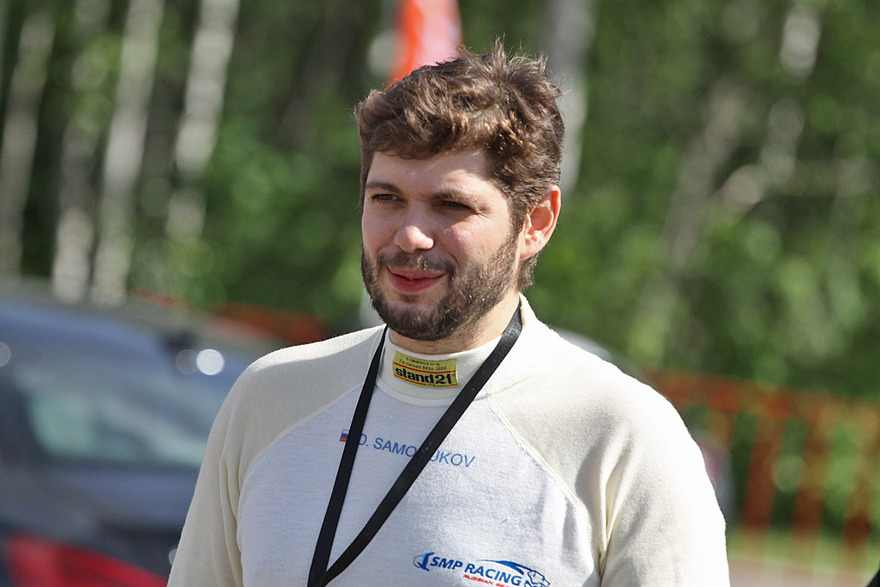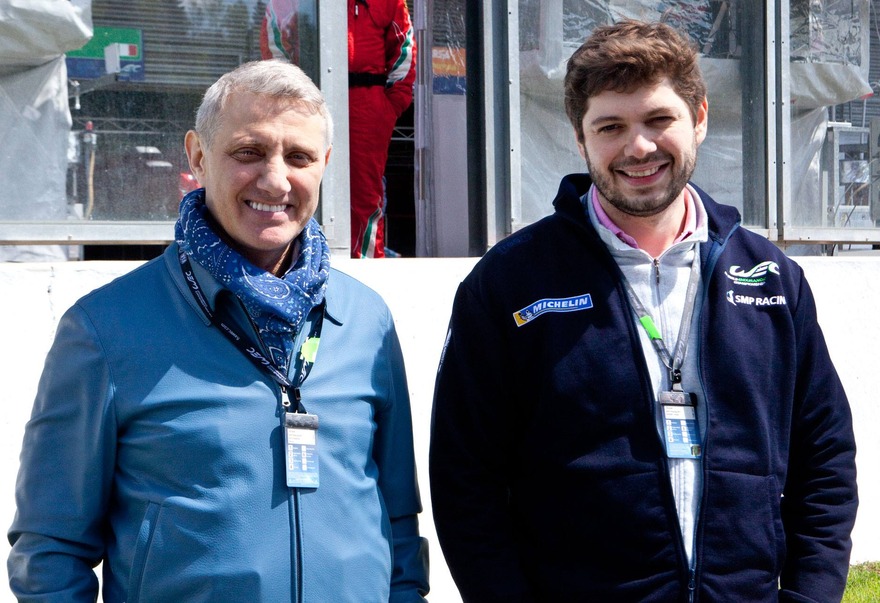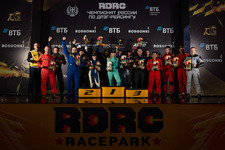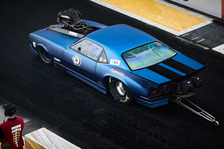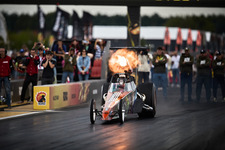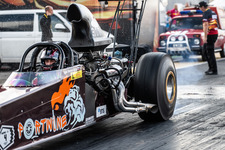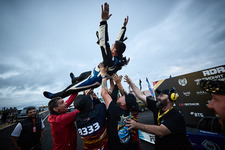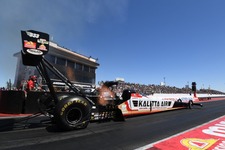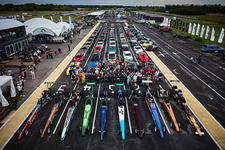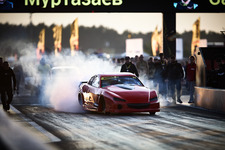Dmitry Samorukov is chief executive of SMP Racing, a programme aimed to support and develop Russian motor sports, founded and headed by Boris Rotenberg. In the end of last year, SMP Racing signed an agreement with the Russian Automobile Federation on promoting two official racing series — the Russian Touring Car Series and the Russian Drag Racing Championship. A company appointed to organise competitions in drag racing was Dragtimes, famous for their Unlim 500+ project — a festival of supercars held near Moscow.
Apart from bearing official titles, Dmitry Samorukov is also a great motor sports fan captivated by powerful sports cars. He is an enthusiastic person always ready to see into many problems of Russian motor sports and work immediately on finding solutions. In addition to that, he sometimes participates in various racing events, including some of the championship rounds. Today we spoke with Dmitry about problems in national drag racing and how to provoke interest not only for joining motor sports but also for staying there.
Dmitry, your company bears a proud name of Russian Drag Racing Championship promoter. What is your personal understanding of this idea and what is your primary goal?
Participating in supporting and developing of Russian motor sports is a social task for us in the first place. We would like to spread the information all over the country, in all regions, reach as many people as possible. I want to rephrase the words of Bernie Ecclestone: “Sure enough, somewhere in Siberia there lives a talented F1 driver, however, we will never hear about him because most probably a boy from Siberia would never get a chance to get into an F1 race car or even touch it”. Therefore, this is our primary goal: to help young talents find their way up. That is why we look out for young children who participate in children's competitions, including karting, and pick out the best of them.
Boris Rotenberg, the founder of the SMP Racing programme, sets his objective in popularising motor sports, making it interesting to watch and involving as many people as possible. Well, of course, the better the results are, the more response we will get. However, it is not just a commercial project, it’s a social programme first of all; that is what Boris Romanovich has actually created it for — to give a chance to Russian motor sports.
What concerns drag racing, today our task as promoters is to help the organisers — Dragtimes company — find sponsors, who might become interested in this motor sports discipline. Apart from financial support, we are ready to provide other resources we have for the moment. We are talking about support in mass media and cooperation with some of our partners.
You have signed a three-year agreement with the Russian Automobile Federation. This year already, you have provided substantial financial support, which helped in organising two major aspects — reimbursement of participants’ expenses for delivery of race cars and also providing of a rather considerable prize fund…
Those are very important aspects. We do understand that drag racing is not in its best shape nowadays and current participants are true heroes who, in 90 percent of cases, support their hobby not with the help of funds coming from sponsors, but with their own money, which is sometimes their last money. And if we want them to participate, if we want to see new faces — and we do want that — we should do something to start with, like, for instance, reimbursing expenses for delivery of race cars to the competition venue.
We have a similar situation with prize funds. We realise how much money a person can spend to prepare his car for one round of competitions and prize fund can actually compensate for expenses. Theoretically, this money should be enough to pay for the fuel and spare parts.
Just before the 3rd round you’ve taken an important decision on increasing the prize fund and appointing prize money according to the overall season’s results. Who made this decision and why?
This decision fully belongs to the organisers — Dragtimes — but SMP Racing is, of course, aware of that. I think it is the right decision, as it will help both in keeping the current participants and in engaging new ones. This decision also had a proper timing. It was taken before the competitions in Novokuznetsk with three more rounds ahead and the overall champion will be determined according to three best results. It added both an extra incentive and a good chance.
SMP Racing and the Russian Automobile Federation have set certain goals for Dragtimes before the beginning of the season. They included promotion of the programme among drivers, participation of striking and fast cars, boosting the number of participants, and discovery of new interesting regions. We want these races to be fascinating and dynamic, making them suitable for TV broadcasting, as the latter will draw attention of participants, spectators, and potential sponsors.
What is your personal opinion on prize funds in motor sports?
I think you would agree that prize funds have a “scent” of “bribing” participants. Well, at least according to one of the versions. Though I know this is not the case here, I want others to understand it also. Drag racing is an expensive sport. Right now, it is fuel led by enthusiasts. That is why our decision to have a prize fund was based on the desire to compensate their expenses at least partially and support human enthusiasm.
Some of our participants, though not many of them, take part in drag racing competitions from one year to the next. They are an example to follow, we would like others to look up to them. These people demonstrate an exception to the rules. They have survived in spite of any difficulties, even in spite of the fact that drag racing has almost perished in our country for some time.
There is another category of participants, who come from illegal races. Having a prize fund is an interesting and fascinating part of drag racing for them. One of our tasks is to take these people away from the streets, show them that civilised motor sport does exist and teach them how to become sportsmen. That is a very difficult but very important task. We work in this direction together with the Russian Automobile Federation: road safety programme. The idea to attract young people who love racing in the city streets to motor sports leaped into our minds during the meeting with the President of the RAF Victor Nikolayevich Kiryanov, who sets this problem as one of the major ones for today. Victor Nikolayevich says “it is impossible to forbid something without offering a replacement”. So, promoting drag racing goes well with this concept.
What results do you expect to get during those three years of contract with the RAF?
We want to have more than a hundred of participants. We want to have a sufficient amount of spectators, so that people participating in competitions could see that someone needs them. We want to have robust partners.
For instance, there were not so many spectators during the event in Krasnoyarsk even though it was well organised. And it’s really sad not to see a big crowd of people at the competitions like that. Both Dragtimes and us are to blame in this situation, I don’t thing track organisers had anything to do with that. It’s a question of cooperation. We need the audience to get interested in drivers and cars, know everything about them; we should keep them informed, keep up their interest, and make nice videos and photos. This is the major part — as soon as we have the right event, we can sell it to sponsors. Then they will start giving money. Not to us but instead us.
The problem is that people in our country don’t know much about motor sports in general and drag racing in particular. Nevertheless, drag racing has its own particular and large targeted audience, which just needs to be shaken up and then we will have spectators, participants, and sponsors.
— You took part in competitions in Krasnoyarsk as a driver. What impressions of Krasnoyarsk did you get behind the wheel of a race car?
I’ll tell you a secret: those were my first drag racing competitions when reaction time was measured! That is why, of course, that was like the first date for me — exciting that much that I even had a false start ☺
The competitions were well organised. From the point of view of a driver, everything was clear, comprehensible, accurate, and fancy. Very well organised indeed!
“Krasnoye koltso” (Red Ring), the circuit in Krasnoyarsk, is a great example of how everything should be done. They found and implemented the right scheme of motor sport developing. They have everything: drift, touring car, and drag racing, a driving school, and motor shows. They do it because they love doing it. It’s a wonderful idea and great implementation of this idea. So hats off to Arkadiy and Evgeny, and of course, Ilya Lykov. There are not so many people like them, but they do exist. I’m also talking about Oleg Petrikov at the Smolensk Ring and Rustem Terigulov at the Moscow Raceway. And there are others.
Do you use the reimbursement of participants’ expenses for delivery of your race car?
I do, because I try to spend money wisely in everything. The car carrier goes there anyway, why shouldn’t I use it and throw money about instead?
What results do you want to achieve in this championship?
I’m preparing my car, want to make it fast, hit 8 seconds and score first place!
Do you have a feeling that you organise this championship for yourself also?
Definitely not. I take part in organising this championship for SMP Racing but not for myself as a driver. I do realise that my personal goals are inconspicuous when talking about proper drag racing. As soon as we have professional teams with sponsorship support, ready to build cars according to international requirements, then we will be able to speak about the inception of true drag racing. But as soon as they emerge, I will be out as a driver. That is why the answer is no, I don’t do it for myself.
You know, if you step back and look at the event, you can see that the organisers were showing off a bit in a rather cute and inoffensive way. Take, for instance, Italian Prosecco instead of the usual “Soviet Champagne” sprayed on the podium. Wouldn’t you agree?
In my opinion, that was not showing off but some Moscow-style glamour. Though many people hate it, sometimes it is relevant. We need all those trifles, and need them to be sophisticated and well thought out. We need the right decorations on the track, it should have a special screen for online broadcast, which should be interesting to watch. Sponsors’ flags and banners should be located along the track. Aesthetics is extremely important so if you want to do something, do it with style. Another important aspect is competence in technical support of the event and judging, which should be professional and fair. That is why we have invited Dragtimes to become organisers of these events. We know that they can make it both professional and beautiful.
At one point, it will concern everything, not just prizes and podium ceremonies. The way food tents look like, whether it is nice and tidy in the paddock area, the way mechanics look like — everything will matter. We want to create a true motor sports civilization. By laying emphasis on all these things, we let everybody see that it is important. As a result, it will bring joy and festive mood to everyone.
The idea of motor sports civilization sounds nice. But how can you implement it?
What we need now is positive energy and alliance of all people interested in motor sports in general and drag racing in particular. Common space, common interests, common motivation. We can’t live in contention; we should all come together, discuss the events, attract new people, and invent something new. Our participants should understand that they form our gold reserves, and that the future of the project depends on them. People should feel involved. We need to get them involved.
Boris Romanovich Rotenberg has initially set it up that each driver in each SMP Racing series not only participates in races but is also engaged in extra work. They participate in adopting the best practices of foreign teams to use them when organising competitions in Russia, work with younger drivers in various disciplines from karting to junior formula series, and do other things. Career of a racing driver is very short, people should have a chance to build their own future. We cannot throw people around, it is just impossible. However, everyone should understand that it’s not only what we need, that’s what everyone needs also.
I think that those people who are engaged in drag racing now are responsible for dragging in new participants. Because current drag racers are just crazy! In a good sense. They are still into it even though drag racing has not been developing for some time. If everyone brings in something good and positive, it will be beneficial for all of us.

